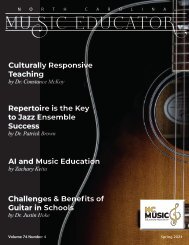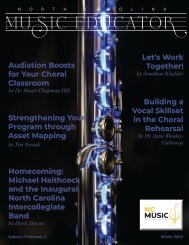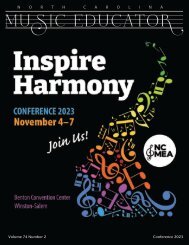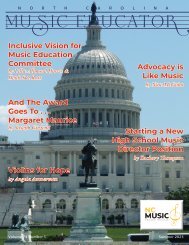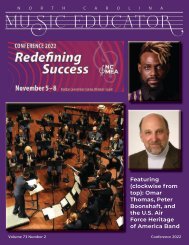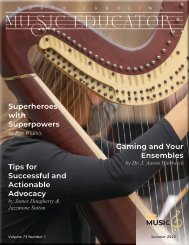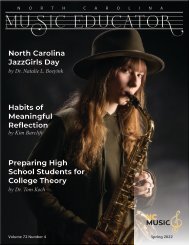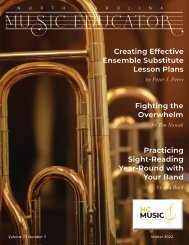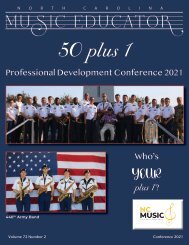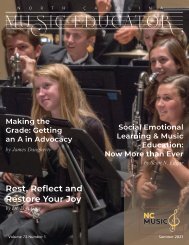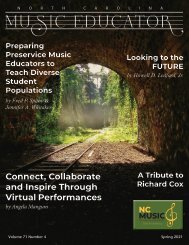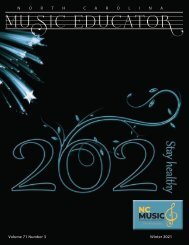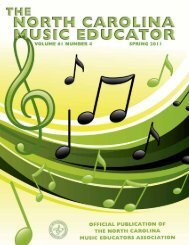North Carolina Music Educator Winter 2023
Professional journal for North Carolina Music Educators Association, winter 2023.
Professional journal for North Carolina Music Educators Association, winter 2023.
Create successful ePaper yourself
Turn your PDF publications into a flip-book with our unique Google optimized e-Paper software.
Evidence-Based<br />
Practice in <strong>Music</strong><br />
Education<br />
by Tim Nowak<br />
There has been a lot of public discussion this year about the<br />
implementation of the science of reading instruction in<br />
<strong>North</strong> <strong>Carolina</strong>. Not being a literacy specialist, I did a quick<br />
Google search to find out more about this. The results suggested<br />
“science of reading” is a collection of instructional methods<br />
variously described as “scientifically-based,” “proven by research,”<br />
or based on a “body of research evidence.”<br />
My thoughts turned to my public school teaching experience<br />
and faculty meetings about “evidence-based instructional<br />
practices.” Admittedly, this was usually near the bottom of my<br />
priority list. Administrators usually focused on “core” teachers,<br />
saying something like, “This doesn’t really apply to you” when<br />
they addressed us “encore” teachers. This always felt like a slight<br />
to the value of our content areas, but if nodding along meant less<br />
paperwork and more time for rehearsal planning, so be it.<br />
But I always had nagging anxiety when it came to my<br />
professional evaluations. What if my principal took the “evidencebased<br />
instruction” box on the rubric seriously this year? What if,<br />
this time, they expected a real answer from me? In this article,<br />
I provide a starting point for you to navigate these discussions.<br />
First, I give some background on the term “evidence-based<br />
practice” in U.S. education. Then I suggest steps you can take to<br />
engage with music education research in your teaching.<br />
Defining “Evidence-Based”<br />
“Evidence-based practice” gained prominence in U.S.<br />
education with No Child Left Behind’s (NCLB’s) mandate<br />
that federally funded education programs be grounded in<br />
“scientifically based research” (Slavin, 2002). The Every Student<br />
Succeeds Act (ESSA) later updated this language to “evidencebased.”<br />
The U.S. Department of Education has established four<br />
levels of evidence that can be used to justify instructional methods<br />
as “evidence-based” for use in different federally funded programs<br />
(Hale et al., 2017). To help state and local education leaders find<br />
methods – or “interventions” – that meet these different levels of<br />
evidence, the Department of Education publishes databases such<br />
as the What Works Clearinghouse, or WWC (https://ies.ed.gov/<br />
ncee/WWC), which review and evaluate the quality of educational<br />
research.<br />
Crucially, the determining factor for rigor in this system is the<br />
methodological design of the research. The top tier of evidence is<br />
reserved for experimental studies, and the WWC only endorses<br />
research with randomized controlled designs (Simpson, 2019).<br />
This type of study is notoriously difficult to construct in education<br />
research, including music education. My search of the WWC<br />
database for “music” only returned eight studies, six of which were<br />
categorized as “don’t meet standards.”<br />
I mention this not to imply that music education research<br />
is somehow grossly inadequate. Rather, my point is that the<br />
dominant discourse of “evidence-based” practice in U.S. education<br />
is so extraordinarily narrow that it excludes vast amounts of<br />
high quality educational research. The conversation is focused<br />
solely on questions about specific interventions for federally<br />
funded programs investigated through inferential statistics. So,<br />
my administrators weren’t wrong; “evidence-based practice,” as<br />
defined by NCLB and ESSA, didn’t really apply to me after all.<br />
But what if we broadened our conception of evidence-based<br />
practice? Davies (1999), for example, argued that “evidence-based<br />
education means integrating individual teaching and learning<br />
expertise with the best available external evidence from systematic<br />
research” (p. 117). In this sense, evidence-based practice is a<br />
continuous process where teachers integrate what they observe<br />
in their specific instructional context with research – of all<br />
methodological designs – that might inform their work toward<br />
specific goals. Below, I offer some suggestions on how you might<br />
approach this in your own classroom.<br />
Finding and Interpreting Evidence<br />
The first step in engaging in evidence-based practice is<br />
establishing a specific goal or outcome the evidence is meant<br />
to inform. Often left unsaid in discussions about “what works”<br />
in education is what something works for. This is where your<br />
professional knowledge and expertise as a musician and teacher<br />
in your local school take center stage. Is there a musical skill<br />
or concept that your students seem to struggle with, such as<br />
improvisation? Is there a general learning process you want<br />
to know more about, such as motivation? Is there a structural<br />
problem in your program you want to improve, such as ensemble<br />
recruitment and retention?<br />
At this stage, your goal can be a vague idea or open ended<br />
question, such as, “I want my general music students to improvise<br />
more,” “How can I motivate my students to practice more?” or “I<br />
want to improve retention in my band program.”<br />
Once you have your general goal in mind, begin searching for<br />
research that relates to that topic. At this point, you’re probably<br />
thinking, “I don’t have time to read a whole bunch of research<br />
articles,” and you’re right. This is where literature reviews can<br />
help. Literature reviews are systematic analyses of a large body<br />
of research on a specific topic and can give you both a summary<br />
of findings and a sense of the complexity of a topic. Update:<br />
Applications of Research in <strong>Music</strong> Education frequently publishes<br />
music education literature reviews, and access is free with your<br />
NAfME/NCMEA membership. There are literature reviews<br />
published in Update about all three of the topics I noted above—<br />
improvisation (Chandler, 2018), motivation (West, 2013), and<br />
retention (Hash, 2022).<br />
Once you’ve found a literature review on your topic of interest,<br />
consider the evidence presented and how it might inform your<br />
teaching, starting with specific questions researchers have<br />
pursued. What facets of the topic have researchers addressed,<br />
and how do their questions relate to what you’re interested in<br />
knowing? For example, Chandler (2018) organized his literature<br />
review of improvisation in elementary general music into four<br />
main lines of inquiry:<br />
• the nature of improvisation,<br />
• instructional time dedicated to improvisation,<br />
• development of improvisation skills with age, and<br />
• effects of improvisation on other skill areas.<br />
Seeing the complexity of the field can help you narrow your<br />
interest from a broad idea – I want my students to improvise more<br />
– to a specific question you can pursue to improve your teaching,<br />
such as “what improvisation activities are appropriate for my<br />
fourth and fifth grade students?”<br />
Next, evaluate the findings addressing the specific question(s)<br />
you’re asking: What answers or solutions do the findings suggest?<br />
How many studies have corroborated those findings? Are there<br />
conflicting findings and, if so, how does the reviewer explain<br />
those different results? For example, West (2013) discussed how<br />
inconsistent findings in motivation research could be related<br />
to different theoretical orientations (p. 15). In other words,<br />
how researchers approached the question of motivation shaped<br />
the results of their studies. In this case, it would be important<br />
for you to consider which theory of motivation seems best<br />
supported by the evidence and which theory might best explain<br />
what you’re experiencing in your school. To be clear, this is not<br />
a suggestion that you should simply find research that confirms<br />
your preexisting beliefs; rather, it is a reminder that context<br />
matters, and that you will need to critically evaluate both your<br />
circumstances and the research evidence to find points of<br />
resonance and tension.<br />
At this point, you may be satisfied with the reviewer’s evidence<br />
and suggestions. If you still have questions, you could do what one<br />
of my mentors called “bibliographic archeology.” Find and read<br />
the original studies in the review that were most intriguing and<br />
evaluate their evidence for yourself. Most studies will begin with a<br />
small literature review that summarizes related findings, and you<br />
could find new sources that support – or contradict – the evidence<br />
you had evaluated previously. You could even find and evaluate<br />
those sources, continuing until you’ve compiled enough evidence<br />
to inform your instructional decisions.<br />
Putting Evidence into Action<br />
Once you’re satisfied with the evidence you’ve compiled,<br />
devise a plan for achieving your desired outcome based on the<br />
research and your professional expertise. How might you tailor<br />
the researcher’s recommendations and integrate them into your<br />
program? Be sure to plan an evaluation to see whether your<br />
plan is working. In other words, what evidence will you need to<br />
collect to investigate whether the plan is working? It could be the<br />
same measures that researchers used, or it could be a measure of<br />
your own – higher grades on improvisation assignments, better<br />
engagement with practice logs, or larger enrollment numbers for<br />
the next academic year.<br />
Whatever your measure, schedule a time to go back and<br />
compare your own evidence to that of the researchers: how is what<br />
you’re finding the same or different? Does the research suggest a<br />
possible explanation for what you’re finding? If not, what other<br />
areas of research might help inform your original question? Keep<br />
in mind, research is constantly changing, so this really will be<br />
a continuous process, as Davies (1999) argued, of integrating<br />
individual expertise with external evidence. Luckily, both NAfME<br />
and NCMEA have resources to keep you informed on the latest<br />
research evidence in music teaching and learning, from published<br />
journals to professional conferences and poster sessions. While<br />
the dominant discourse of evidence-based practice may not<br />
be intended for music educators, we can still use evidence to<br />
inform what we do and continually improve the practice of music<br />
teaching and learning.<br />
References<br />
Chandler, M. (2018). Improvisation in elementary general music:<br />
A review of the literature. Update: Applications of Research in <strong>Music</strong><br />
Education, 37(1), 42-48. https://doi.org/10.1177/8755123318763002<br />
Davies, P. (1999). What is evidence-based education? British Journal<br />
of Educational Studies, 47(2), 108-121. https://doi.org/10.1111/1467-<br />
8527.00106<br />
Hale, S., Dunn, L., Filby, N, Rice, J., & Van Houten, L. (2017).<br />
Evidence-based improvement: A guide for states to strengthen their<br />
frameworks and supports aligned to the evidence requirements of ESSA.<br />
WestEd.<br />
Hash, P. (2022). Student retention in school bands and orchestras: A<br />
literature review. Update: Applications of Research in <strong>Music</strong> Education,<br />
40(3), 11-19. https://doi.org/10.1177/87551233211042585<br />
Simpson, A. (2019). The evidential basis of “evidence-based education”:<br />
An introduction to the special issue. Educational Research and Evaluation,<br />
25(1-2), 1-6. https://doi.org/10.1080/13803611.2019.1617979<br />
Slavin, R. E. (2002) Evidence-based education policies: Transforming<br />
educational practice and research. Educational Researcher, 31(7), 15-21.<br />
https://doi.org/10.3102/0013189X031007015<br />
West, C. (2013). Motivating music students: A review of the literature.<br />
Update: Applications of Research in <strong>Music</strong> Education, 31(2), 11-19.<br />
https://doi.org/10.1177/8755123312473611<br />
14 | NORTH CAROLINA MUSIC EDUCATOR NORTH CAROLINA MUSIC EDUCATOR | 15




